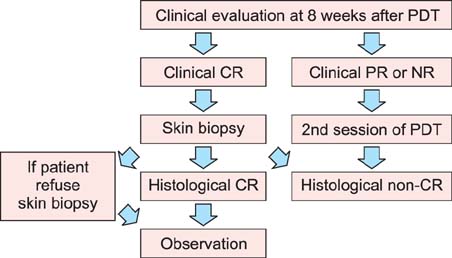Ann Dermatol.
2013 Nov;25(4):417-422. 10.5021/ad.2013.25.4.417.
Photodynamic Therapy with Ablative Carbon Dioxide Fractional Laser in Treatment of Actinic Keratosis
- Affiliations
-
- 1Department of Dermatology, Kyungpook National University School of Medicine, Daegu, Korea.
- 2Department of Dermatology, Ajou University School of Medicine, Suwon, Korea. maychan@ajou.ac.kr
- KMID: 2265047
- DOI: http://doi.org/10.5021/ad.2013.25.4.417
Abstract
- BACKGROUND
Recently, photodynamic therapy (PDT) has been shown to be an effective first-line treatment for actinic keratosis (AK). However, a major limitation of PDT is the long incubation time required to allow penetration of the photosensitizer.
OBJECTIVE
The aim of this study was to assess if pretreatment with an ablative carbon dioxide (CO2) fractional laser can reduce the incubation time of the photosensitizer.
METHODS
Initially, 29 patients with a total of 34 AK lesions were treated with an ablative CO2 fractional laser at Ajou University Hospital between January and December 2010. Immediately after the laser treatment, topical 20% 5-aminolevulinic acid or methyl-aminolevulinate was applied to the AK lesions and incubated for 70 to 90 minutes. Then, the treated areas were illuminated with a red light source. Improvement was clinically or histologically assessed eight weeks after the treatment.
RESULTS
In spite of the short incubation time, 24 lesions (70.6%) showed a complete response (CR) within three sessions of PDT (10 lesions a clinical CR and 14 lesions a clinical/histological CR). There were no significant side effects associated with the combination of ablative CO2 fractional laser and PDT.
CONCLUSION
Ablative CO2 fractional laser may be considered an additional treatment option for reducing the incubation time of the photosensitizer in PDT.
MeSH Terms
Figure
Cited by 2 articles
-
Ablative Fractional Radiofrequency Combined with Sonophoresis Increases Skin Penetration of Indocyanine Green
Hee-Kyeong Lim, Ki-Heon Jeong, Min Kyung Shin
Ann Dermatol. 2015;27(3):343-345. doi: 10.5021/ad.2015.27.3.343.A Case of Bowen's Disease Successfully Treated with Ingenol Mebutate Gel
Je-Byeong Chae, Jung-Tae Park, Bo-Ri Kim, Chang-Hun Huh, Kyoung-Chan Park, Jung-Won Shin
Ann Dermatol. 2017;29(4):523-524. doi: 10.5021/ad.2017.29.4.523.
Reference
-
1. Ericson MB, Wennberg AM, Larkö O. Review of photodynamic therapy in actinic keratosis and basal cell carcinoma. Ther Clin Risk Manag. 2008; 4:1–9.2. Martin G. The impact of the current United States guidelines on the management of actinic keratosis: is it time for an update? J Clin Aesthet Dermatol. 2010; 3:20–25.3. Klein A, Babilas P, Karrer S, Landthaler M, Szeimies RM. Photodynamic therapy in dermatology--an update 2008. J Dtsch Dermatol Ges. 2008; 6:839–845.4. Szeimies RM, Karrer S, Radakovic-Fijan S, Tanew A, Calzavara-Pinton PG, Zane C, et al. Photodynamic therapy using topical methyl 5-aminolevulinate compared with cryotherapy for actinic keratosis: a prospective, randomized study. J Am Acad Dermatol. 2002; 47:258–262.
Article5. MacCormack MA. Photodynamic therapy in dermatology: an update on applications and outcomes. Semin Cutan Med Surg. 2008; 27:52–62.
Article6. Goldberg DJ. Photodynamic therapy in skin rejuvenation. Clin Dermatol. 2008; 26:608–613.
Article7. Haedersdal M, Sakamoto FH, Farinelli WA, Doukas AG, Tam J, Anderson RR. Fractional CO(2) laser-assisted drug delivery. Lasers Surg Med. 2010; 42:113–122.
Article8. Ortiz-Policarpio B, Lui H. Methyl aminolevulinate-PDT for actinic keratoses and superficial nonmelanoma skin cancers. Skin Therapy Lett. 2009; 14:1–3.9. Smucler R, Vlk M. Combination of Er:YAG laser and photodynamic therapy in the treatment of nodular basal cell carcinoma. Lasers Surg Med. 2008; 40:153–158.
Article10. Fang YP, Wu PC, Tsai YH, Huang YB. Physicochemical and safety evaluation of 5-aminolevulinic acid in novel liposomes as carrier for skin delivery. J Liposome Res. 2008; 18:31–45.
Article11. Fang JY, Lee WR, Shen SC, Fang YP, Hu CH. Enhancement of topical 5-aminolaevulinic acid delivery by erbium:YAG laser and microdermabrasion: a comparison with iontophoresis and electroporation. Br J Dermatol. 2004; 151:132–140.
Article12. de Leeuw J, van der Beek N, Bjerring P, Neumann HA. Photodynamic therapy of acne vulgaris using 5-aminolevulinic acid 0.5% liposomal spray and intense pulsed light in combination with topical keratolytic agents. J Eur Acad Dermatol Venereol. 2010; 24:460–469.
Article13. Clementoni MT, B-Roscher M, Munavalli GS. Photodynamic photorejuvenation of the face with a combination of microneedling, red light, and broadband pulsed light. Lasers Surg Med. 2010; 42:150–159.
Article14. Fukui T, Watanabe D, Tamada Y, Matsumoto Y. Photodynamic therapy following carbon dioxide laser enhances efficacy in the treatment of extramammary Paget's disease. Acta Derm Venereol. 2009; 89:150–154.15. Bogdan Allemann I, Kaufman J. Fractional photothermolysis-an update. Lasers Med Sci. 2010; 25:137–144.
Article16. Yoo KH, Kim BJ, Kim MN. Enhanced efficacy of photodynamic therapy with methyl 5-aminolevulinic acid in recalcitrant periungual warts after ablative carbon dioxide fractional laser: a pilot study. Dermatol Surg. 2009; 35:1927–1932.
Article17. Kim HS, Yoo JY, Cho KH, Kwon OS, Moon SE. Topical photodynamic therapy using intense pulsed light for treatment of actinic keratosis: clinical and histopathologic evaluation. Dermatol Surg. 2005; 31:33–36.
Article18. Itoh Y, Ninomiya Y, Henta T, Tajima S, Ishibashi A. Topical delta-aminolevulinic acid-based photodynamic therapy for Japanese actinic keratoses. J Dermatol. 2000; 27:513–518.
Article
- Full Text Links
- Actions
-
Cited
- CITED
-
- Close
- Share
- Similar articles
-
- A Case of Squamous Cell Carcinoma Treated with Photodynamic Therapy with Ablative Carbon Dioxide Fractional Laser
- A Case of Squamous Cell Carcinoma Treated with Photodynamic Therapy with Ablative Carbon Dioxide Fractional Laser
- Photodynamic Therapy with Ablative Carbon Dioxide Fractional Laser for Treating Bowen Disease
- Successful Treatment of Granuloma Annulare Using Ablative Fractional Carbon Dioxide Laser-Assisted Photodynamic Therapy
- Refractory Non-segmental Vitiligo Effectively Treated with Ablative Fractional Carbon Dioxide Laser





